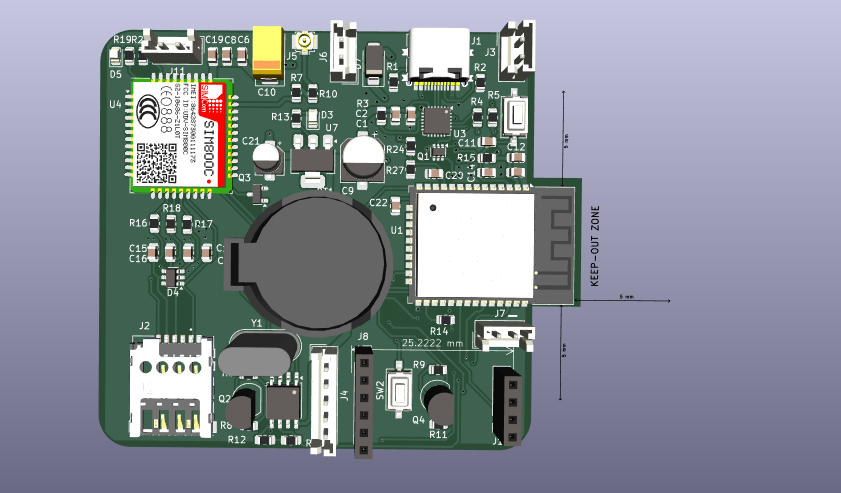Become a leader in the IoT community!
Join our community of embedded and IoT practitioners to contribute experience, learn new skills and collaborate with other developers with complementary skillsets.

Join our community of embedded and IoT practitioners to contribute experience, learn new skills and collaborate with other developers with complementary skillsets.



Hello everyone, I have a design I need to send to production tonight, the design just came in some hours ago.. It’s an IOT board. In the firmware, I will use GPRS, WIFI, and Bluetooth. Please I just need a quick review, i would appreciate any pointers and adjustments. I am not through with the routing and placements yet.






The system will be powered by a lithium ion battery, 3.7v 6000mah. The battery will be connected to the board using J6 connector
The design is ok, just make sure the width of the traces are well calculated for current capacity and also those that need impedance control, is been well calculated. But much more, make sure that your design is within the manufacturer capabilities, so your board can be manufacturable. For me id just say that there are much space left on the PCB
thank you @josephogbonna. This is what i have for now, any thoughts please?


Its great 👍
A few thoughts:
1. – if you’re using WIFI from that ESPxx module (or maybe even if you’re not), you may want to consider keeping the filled area out below it. I see you kept out the area below the antenna. so I suppose that will take care of most of it (had some of this written before seeing that), but couldn’t hurt. Also seems like I’ve seen something about keeping the area with a crystal clear of fill as well, maybe that would apply to the ESPxx module as well, not sure.
2. – I would consider using stitching vias to attach the two plans together in more spots (seems they’re both ground), though that’s just something that seems good to me and I couldn’t prove that it is better. That would allow you to fill in that blank bit on one side in the lower-right portion too.
But those are just my thoughts and probably not that important to its functionality. All the best with it!
Thank you @jeremycook, i will probably consider stitching vias in the next iteration, i have pushed to production
Re: Cutouts – Got this datalogging board https://www.tindie.com/products/smartbee/esp32-data-logger-wrtc-sd/ to review/use. Noticed the ESP32 module has a literal cutout in the PCB over the antenna, with mounting holes straddling it. Also looks like the design has copper fill under the ESP32 module otherwise, at least on the bottom. Something to consider, looks like there is a ton of documentation on the listing if you feel like checking it out.


Thank you @jeremycook I’ll go through the docs.
nice one
@afuevu_dear how did you implement the SIM chip with sim card holder on your board?
Hello @fatogoma18 I used the hardware design doc of the sim800c and just replicated what they did. You can take a look at the doc here: https://www.elecrow.com/download/SIM800C_Hardware_Design_V1.02.pdf?srsltid=AfmBOorY6oz7AL4cgSDaIysTtLAhoa5lKy994osALyptUmMgVj-CYDTH page 31
The boards have arrived from JLCPCB, I am going to solder the usb type c and check for power on th board





CONTRIBUTE TO THIS THREAD